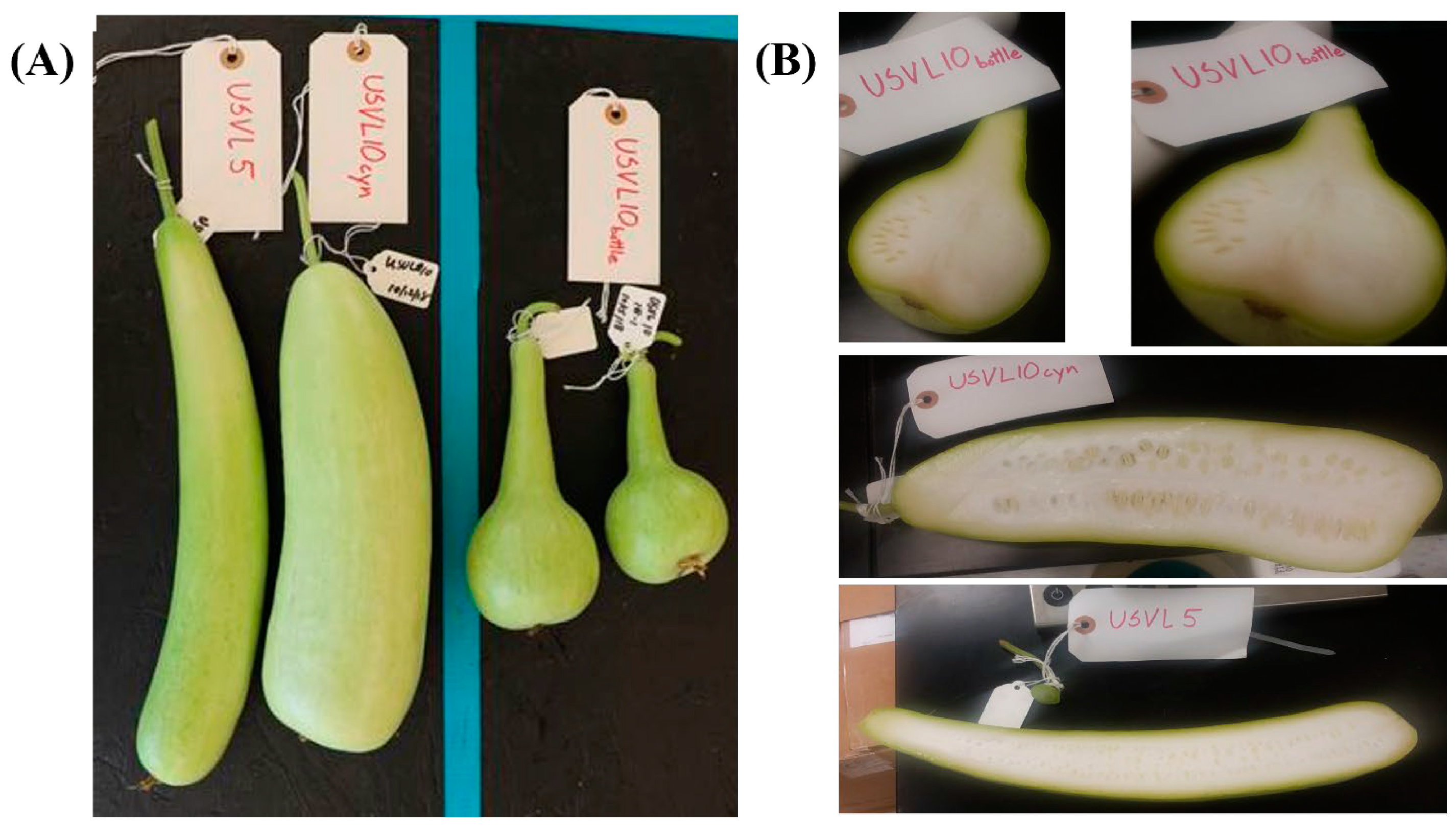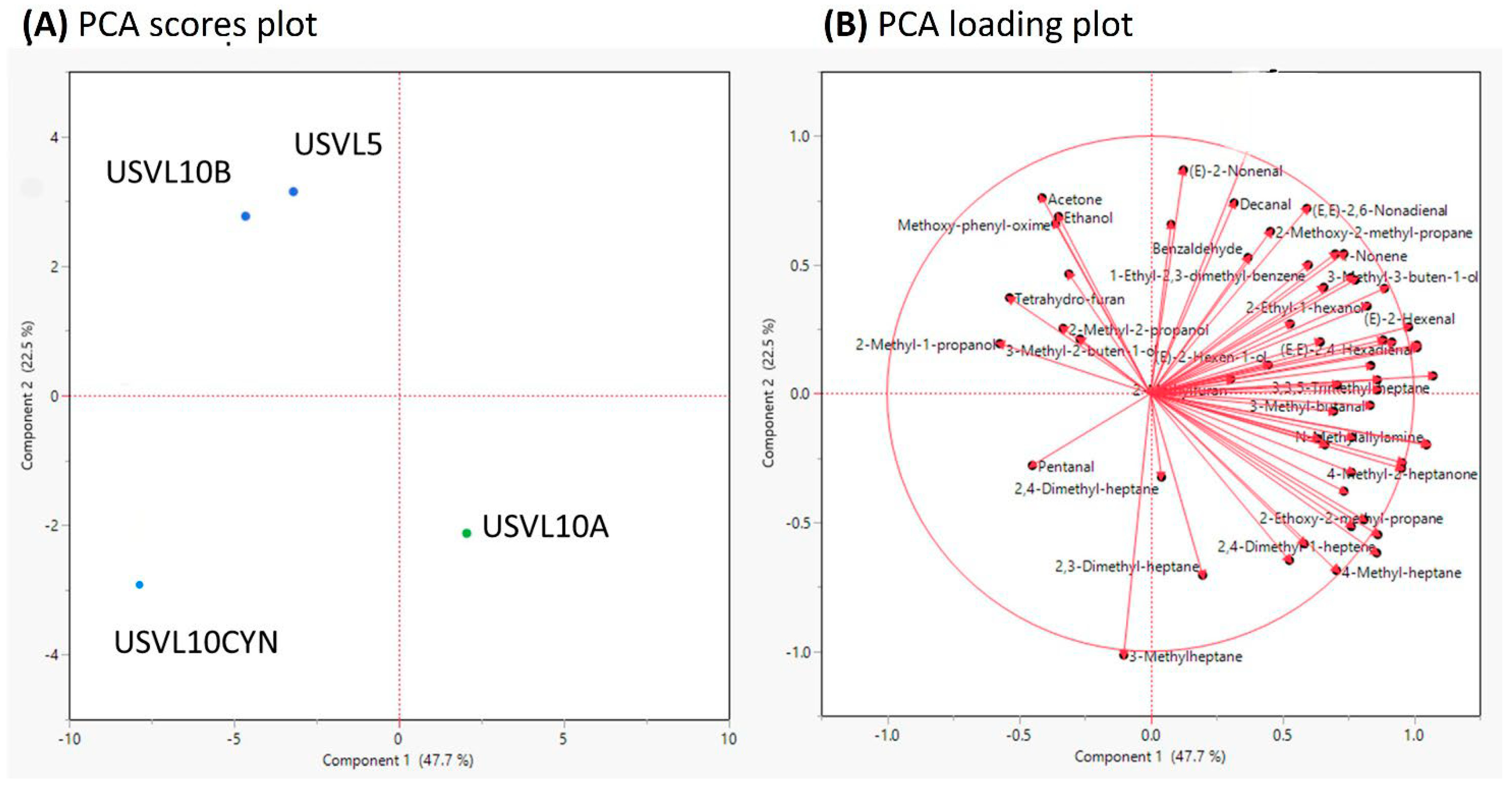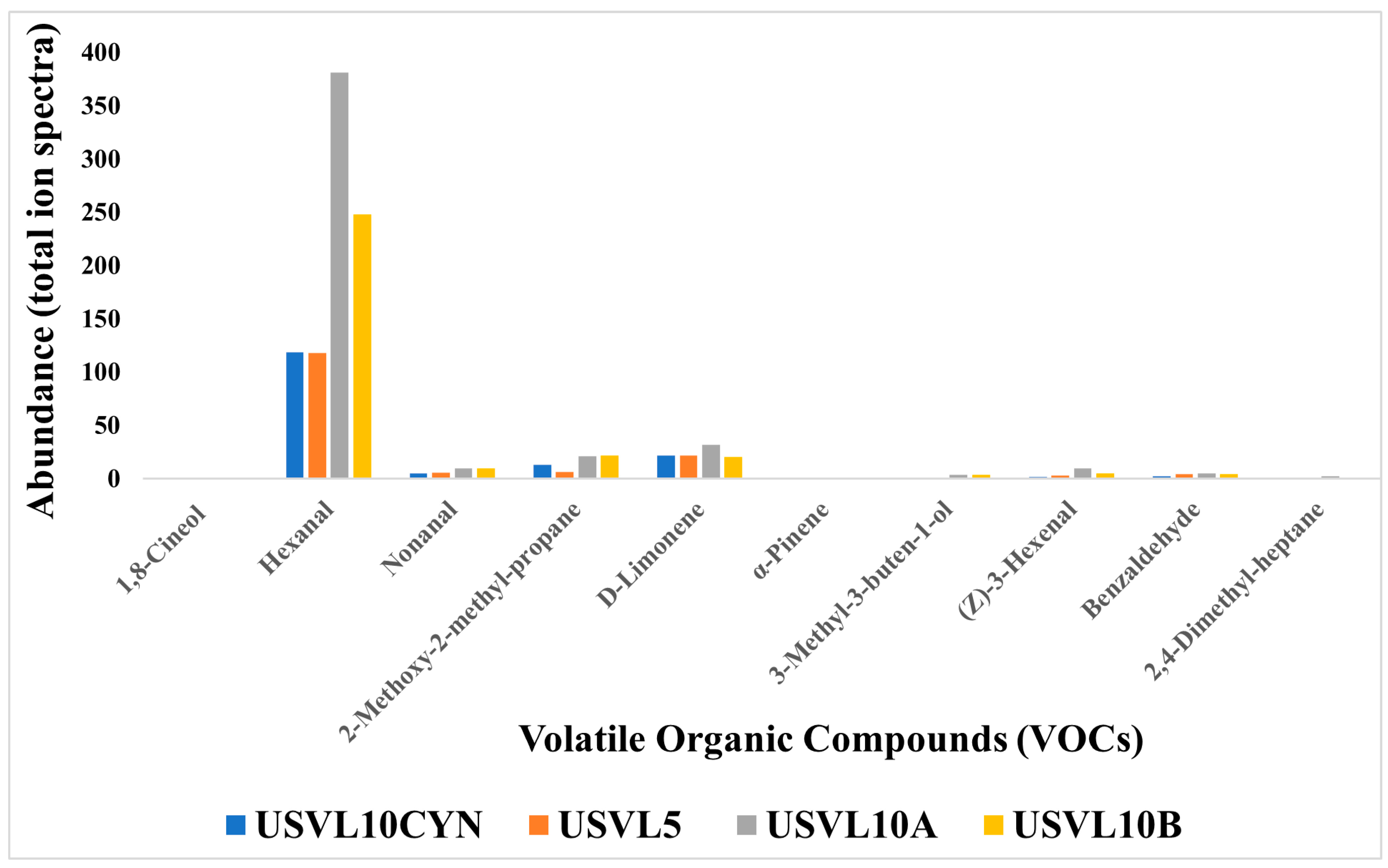Comparative Evaluation of Volatile Organic Compounds in Two Bottle Gourd Accessions with Distinct Fruit Shapes
Abstract
:1. Introduction
2. Materials and Methods
2.1. Plant Material, Chemicals and Reagents
2.2. Sample Preparation and Determination of VOCs
2.3. Statistical Analysis
3. Results
3.1. VOC Profile of the Tested Bottle Gourd Accessions and Derivatives
3.2. Ranking of Bottle Gourd Accessions for Identified VOCs
3.3. Functional Profiling of Identified VOCs among the Tested Accessions
4. Discussion
4.1. Domestic Use of Identified VOCs and Bottle Gourd Accessions
4.2. Potential Use of Bottle Gourd Accessions with Respect to VOC Profile in Health Care Industry
4.3. Suitability of Tested Bottle Gourd Accessions as Important Modulators of Plant Health and Agriculture
5. Conclusions
Author Contributions
Funding
Data Availability Statement
Conflicts of Interest
References
- Ahuja, S.; Ahuja, S.; Ahuja, U. Bottle Gourd—History, Uses, and Folklore. Asian Agri-Hist. 2011, 15, 305–310. [Google Scholar]
- Natarajan, S. Morphological Diversity for Fruit Characters in Bottle Gourd Germplasm from Tribal Pockets of Telangana Region of Andhra Pradesh, India. Asian Agri-Hist. 2005, 9, 305–310. [Google Scholar]
- Yetisir, H.; Sakar, M.; Serce, S. Collection and morphological characterization of Legenaria siceraria germplasm form the Mediterranean Region of Turkey. Genet. Resour. Crop Evol. 2008, 55, 1257–1266. [Google Scholar] [CrossRef]
- Wang, Y.; Xu, P.; Wu, X.; Wu, X.; Wang, B.; Huang, Y.; Hu, Y.; Lin, J.; Lu, Z.; Li, G. GourdBase: A genome-centered multi-omics database for the bottle gourd (Lagenaria siceraria), an economically important cucurbit crop. Sci. Rep. 2018, 8, 3604. [Google Scholar] [CrossRef] [PubMed]
- Guler, Z.; Karaca, F.; Yetisir, H. Volatile compounds in the peel and flesh of cucumber (Cucumis sativus L.) grafted onto bottle gourd (Lagenaria siceraria) rootstock. J. Hortic. Sci. Biotechnol. 2013, 88, 123–128. [Google Scholar] [CrossRef]
- Ling, K.-S.; Levi, A.; Adkins, S.; Kousik, C.S.; Miller, G.; Hassell, R.; Keinath, A.P. Development and Field Evaluation of Multiple Virus-Resistant Bottle Gourd (Lagenaria siceraria). Plant Dis. 2013, 97, 1057–1062. [Google Scholar] [CrossRef]
- Cho, S.-H.; Joung, Y.H.; Karna, S.; Lee, H.E.; Kim, J.H.; Kim, J.H.; Kim, D.S.; Ahn, Y.K. The development of cold resistance rootstock using Agrobacterium-mediated transformation of Arabidopsis CBF3/DREB1A in bottle gourd (Lageneraria siceraria Standl.). Sci. Hortic. 2017, 214, 141–146. [Google Scholar] [CrossRef]
- Kumar, V.; Hussain, P.R.; Chatterjee, S.; Variyar, P.S. Evaluation of In Vitro Antioxidant Activity and Characterization of Phenolic Compounds of Bottle Gourd towards the Green Synthesis of Gold Nanoparticles and Its Bio-efficacy. Int. J. Food Nutr. Saf. 2015, 6, 125–149. [Google Scholar]
- Zahoor, M.; Ikram, M.; Nazir, N.; Naz, S.; Batiha, G.E.; Kamran, A.W.; Tomczyk, M.; Kabrah, A. A Comprehensive Review on the Medicinal Importance; Biological and Therapeutic Efficacy of Lagenaria siceraria (Mol.) (Bottle Gourd) Standley Fruit. Curr. Top. Med. Chem. 2021, 21, 1788–1803. [Google Scholar] [CrossRef]
- Assessment of effects on health due to consumption of bitter bottle gourd (Lagenaria siceraria) juice. Indian. J. Med. Res. 2012, 135, 49–55. [CrossRef]
- Guler, Z.; Candir, E.; Yetisir, H.; Karaca, F.; Solmaz, I. Volatile organic compounds in watermelon (Citrullus lanatus) grafted onto 21 local and two commercial bottle gourd (Lagenaria siceraria) rootstocks. J. Hortic. Sci. Biotechnol. 2014, 89, 448–452. [Google Scholar] [CrossRef]
- Jo, H.E.; Song, K.; Kim, J.-G.; Lee, C.H. Non-targeted metabolomic analysis for the comparative evaluation of volatile organic compounds in 20 globally representative cucumber lines. Front. Plant Sci. 2022, 13, 1028735. [Google Scholar] [CrossRef] [PubMed]
- Zhang, J.; Gu, X.; Yan, W.; Lou, L.; Xu, X.; Chen, X. Characterization of Differences in the Composition and Content of Volatile Compounds in Cucumber Fruit. Foods 2022, 11, 1101. [Google Scholar] [CrossRef]
- Du, X.; Routray, J.; Williams, C.; Weng, Y. Association of Refreshing Perception with Volatile Aroma Compounds, Organic Acids, and Soluble Solids in Freshly Consumed Cucumber Fruit. ACS Food Sci. Technol. 2022, 2, 1495–1506. [Google Scholar] [CrossRef]
- El-Akad, R.H.; El-Din, M.G.S.; Farag, M.A. How Does Lagenaria siceraria (Bottle Gourd) Metabolome Compare to Cucumis sativus (Cucumber) F. Cucurbitaceae? A Multiplex Approach of HR-UPLC/MS/MS and GC/MS Using Molecular Networking and Chemometrics. Foods 2023, 12, 771. [Google Scholar] [CrossRef]
- Palamthodi, S.; Kadam, D.; Lele, S.S. Physicochemical and functional properties of ash gourd/bottle gourd beverages blended with jamun. J. Food Sci. Technol. 2019, 56, 473–482. [Google Scholar] [CrossRef]
- Chatterjee, S.; Sharma, J.; Variyar, P.S.; Sharma, A. Free and glycosidically bound volatiles of some common Indian vegetables. Electron. J. Environ. Agric. Food Chem. 2009, 8, 613–620. [Google Scholar]
- Bai, J.; Baldwin, E.; Hearn, J.; Driggers, R.; Stover, E. Volatile and Nonvolatile Flavor Chemical Evaluation of USDA Orange–Mandarin Hybrids for Comparison to Sweet Orange and Mandarin Fruit. J. Amer. Soc. Hort. Sci. 2016, 141, 339–350. [Google Scholar] [CrossRef]
- da Cruz, M.A.; Plotto, A.; Ferrarezi, R.S.; Leite Junior, R.P.; Bai, J. Effect of Huanglongbing on the Volatile Organic Compound Profile of Fruit Juice and Peel Oil in ‘Ray Ruby’ Grapefruit. Foods 2023, 12, 713. [Google Scholar] [CrossRef]
- Galili, T.; O’callaghan, A.; Sidi, J.; Sievert, C. Heatmaply: An R package for creating interactive cluster heatmaps for online publishing. Bioinformatics 2017, 34, 1600–1602. [Google Scholar] [CrossRef]
- Sánchez, J.; Mardia, K.V.; Kent, J.T.; Bibby, J.M. Multivariate Analysis. Academic Press, London-New York-Toronto-Sydney-San Francisco 1979. xv, 518 pp., $ 61.00. Biom. J. 1982, 24, 502. [Google Scholar] [CrossRef]
- Lee, B.; Lin, P.-C.; Cha, H.S.; Luo, J.; Chen, F. Characterization of volatile compounds in Cowart muscadine grape (Vitis rotundifolia) during ripening stages using GC-MS combined with principal component analysis. Food Sci. Biotechnol. 2016, 25, 1319–1326. [Google Scholar] [CrossRef] [PubMed]
- Issitt, T.; Wiggins, L.; Veysey, M.; Sweeney, S.T.; Brackenbury, W.J.; Redeker, K. Volatile compounds in human breath: Critical review and meta-analysis. J. Breath. Res. 2022, 16, 024001. [Google Scholar] [CrossRef] [PubMed]
- Song, G.C.; Ryu, C.M. Two volatile organic compounds trigger plant self-defense against a bacterial pathogen and a sucking insect in cucumber under open field conditions. Int. J. Mol. Sci. 2013, 14, 9803–9819. [Google Scholar] [CrossRef]
- Beltrán Sanahuja, A.; García, A.V. New Trends in the Use of Volatile Compounds in Food Packaging. Polymers 2021, 13, 1053. [Google Scholar] [CrossRef]
- Sebaaly, C.; Charcosset, C.; Fourmentin, S.; Greige-Gerges, H. Potential Applications of Cyclodextrin Inclusion Complexes, Liposomes, and Drug-in-Cyclodextrin-in-Liposome in Food Industry and Packaging. In Role of Materials Science in Food Bioengineering; Academic Press: Cambridge, MA, USA, 2018. [Google Scholar]
- Gharib, R.; Jemâa, J.M.; Charcosset, C.; Fourmentin, S.; Greige-Gerges, H. Retention of Eucalyptol, a Natural Volatile Insecticide, in Delivery Systems Based on Hydroxypropyl-β-Cyclodextrin and Liposomes. Eur. J. Lipid Sci. Technol. 2020, 122, 1900402. [Google Scholar] [CrossRef]
- Xavier, L.O.; Sganzerla, W.G.; Rosa, G.B.; da Rosa, C.G.; Agostinetto, L.; Veeck, A.P.d.L.; Bretanha, L.C.; Micke, G.A.; Costa, M.D.; Bertoldi, F.C.; et al. Chitosan packaging functionalized with Cinnamodendron dinisii essential oil loaded zein: A proposal for meat conservation. Int. J. Biol. Macromol. 2021, 169, 183–193. [Google Scholar] [CrossRef]
- Nikfar, S.; Behboudi, A.F. Limonene. In Encyclopedia of Toxicology, 3rd ed.; Wexler, P., Ed.; Academic Press: Oxford, UK, 2014; pp. 78–82. [Google Scholar]
- Li, X.; Li, X.; Wang, T.; Gao, W. Nutritional composition of pear cultivars (Pyrus spp.). In Nutritional Composition of Fruit Cultivars; Elsevier: Amsterdam, The Netherlands, 2016; pp. 573–608. [Google Scholar]
- Abdel-Razek, A.G.; Badr, A.N.; Alharthi, S.S.; Selim, K.A. Efficacy of Bottle Gourd Seeds’ Extracts in Chemical Hazard Reduction Secreted as Toxigenic Fungi Metabolites. Toxins 2021, 13, 789. [Google Scholar] [CrossRef]
- Janfaza, S.; Khorsand, B.; Nikkhah, M.; Zahiri, J. Digging deeper into volatile organic compounds associated with cancer. Biol. Methods Protoc. 2019, 4, bpz014. [Google Scholar] [CrossRef]
- Anandakumar, P.; Kamaraj, S.; Vanitha, M.K. D-limonene: A multifunctional compound with potent therapeutic effects. J. Food Biochem. 2021, 45, e13566. [Google Scholar] [CrossRef]
- Chebet, J.J.; Ehiri, J.E.; McClelland, D.J.; Taren, D.; Hakim, I.A. Effect of d-limonene and its derivatives on breast cancer in human trials: A scoping review and narrative synthesis. BMC Cancer 2021, 21, 902. [Google Scholar] [CrossRef] [PubMed]
- Pries, R.; Jeschke, S.; Leichtle, A.; Bruchhage, K.-L. Modes of Action of 1,8-Cineol in Infections and Inflammation. Metabolites 2023, 13, 751. [Google Scholar] [CrossRef] [PubMed]
- Saitoh, J.; Saya, H. Abstract 4758: Benzaldehyde suppresses multiple signal pathways in cancer cells by regulating 14-3-3ζ-mediated protein-protein interactions. Cancer Res. 2016, 76 (Suppl. S14), 4758. [Google Scholar] [CrossRef]
- Scala, A.; Allmann, S.; Mirabella, R.; Haring, M.A.; Schuurink, R.C. Green Leaf Volatiles: A Plant’s Multifunctional Weapon against Herbivores and Pathogens. Int. J. Mol. Sci. 2013, 14, 17781–17811. [Google Scholar] [CrossRef]
- Jiao, C.; Guo, Z.; Gong, J.; Zuo, Y.; Li, S.; Vanegas, D.; McLamore, E.S.; Shen, Y. CML8 and GAD4 function in (Z)-3-hexenol-mediated defense by regulating γ-aminobutyric acid accumulation in Arabidopsis. Plant Physiol. Biochem. 2022, 186, 135–144. [Google Scholar] [CrossRef] [PubMed]
- Maurya, A.K.; Pazouki, L.; Frost, C.J. Priming Seeds with Indole and (Z)-3-Hexenyl Acetate Enhances Resistance Against Herbivores and Stimulates Growth. J. Chem. Ecol. 2022, 48, 441–454. [Google Scholar] [CrossRef]
- Jin, J.; Zhao, M.; Jing, T.; Zhang, M.; Lu, M.; Yu, G.; Wang, J.; Guo, D.; Pan, Y.; Hoffmann, T.D.; et al. Volatile compound-mediated plant–plant interactions under stress with the tea plant as a model. Hortic. Res. 2023, 10, 143. [Google Scholar] [CrossRef]
- Heil, M.; Lion, U.; Boland, W. Defense-Inducing Volatiles: In Search of the Active Motif. J. Chem. Ecol. 2008, 34, 601–604. [Google Scholar] [CrossRef]
- Abd-Alla, M.A.; El-Mougy, N.S.; Abd-El-Kader, M.M.; Abd-El-Kareem, F.; El-Gamal, N.G.; El-Mohamedy, R.S. Aldehydes Compounds for Controlling Black Scurf Disease of Potato (Solanum tubrosum L.) under Field Conditions. Int. J. Agric. For. 2013, 3, 34–39. [Google Scholar]





| Compound | RT | RI | Abundance (Total Ion Current (×106)) | |||
|---|---|---|---|---|---|---|
| USVL10CYN | USVL5 | USVL10A | USVL10B | |||
| Aliphatic alcohols | ||||||
| Ethanol | 9.304 | 480 | 3.85 | 0.88 | 1.92 | 4.98 |
| 2-Methyl-2-propanol | 11.056 | 532 | 7.50 | 0.89 | 4.03 | 2.61 |
| 2-Methyl-1-propanol | 14.389 | 623 | 0.80 | 0.00 | 0.00 | 0.00 |
| 1-Penten-3-ol | 16.741 | 683 | 2.18 | 5.71 | 4.50 | 3.26 |
| 3-Methyl-3-buten-1-ol | 18.989 | 737 | 0.87 | 0.91 | 3.86 | 3.91 |
| 2-Methyl-1-butanol | 19.196 | 742 | 0.00 | 0.61 | 0.75 | 0.76 |
| (Z)-2-Penten-1-ol | 20.410 | 771 | 1.22 | 1.30 | 1.65 | 1.27 |
| 3-Methyl-2-buten-1-ol | 20.799 | 780 | 0.00 | 0.00 | 0.53 | 0.82 |
| (E)-2-Hexen-1-ol | 25.006 | 874 | 0.00 | 0.00 | 0.84 | 0.74 |
| 1-Hexanol | 25.120 | 877 | 2.15 | 3.38 | 6.47 | 5.81 |
| 2-Methylbutan-2-ol | 15.071 | 641 | 3.63 | 0.75 | 3.00 | 2.35 |
| 2-Ethyl-1-hexanol | 32.299 | 1038 | 0.57 | 0.52 | 1.00 | 0.78 |
| Aliphatic aldehydes | ||||||
| Decanal | 12.093 | 561 | 1.35 | 1.25 | 1.59 | 1.60 |
| 3-Methyl-butanal | 15.740 | 658 | 1.18 | 13.77 | 17.17 | 16.48 |
| 2-Methyl-butanal | 16.139 | 668 | 0.65 | 10.90 | 15.12 | 13.53 |
| Pentanal | 17.459 | 701 | 4.28 | 6.37 | 3.46 | 4.94 |
| (Z)-3-Hexenal | 22.025 | 808 | 1.38 | 2.99 | 9.95 | 4.94 |
| Hexanal | 22.178 | 811 | 118.94 | 117.85 | 381.07 | 247.74 |
| (E)-2-Hexenal | 24.713 | 868 | 98.21 | 204.48 | 412.63 | 295.18 |
| (E,E)-2,4-Hexadienal | 27.435 | 928 | 1.75 | 5.86 | 22.03 | 10.62 |
| Octanal | 31.346 | 1016 | 0.67 | 0.69 | 1.13 | 0.92 |
| Nonanal | 35.566 | 1115 | 4.71 | 5.68 | 9.85 | 9.99 |
| (E,E)-2,6-Nonadienal | 37.641 | 1167 | 0.81 | 0.84 | 1.92 | 1.87 |
| 2-Methyl-propanal | 37.865 | 1173 | 0.61 | 3.18 | 3.27 | 3.52 |
| (E)-2-Nonenal | 39.522 | 1217 | 2.81 | 1.94 | 3.48 | 3.73 |
| Aliphatic ketones | ||||||
| Acetone | 10.145 | 505 | 86.07 | 54.72 | 47.35 | 97.93 |
| 1-Penten-3-one | 16.877 | 686 | 1.25 | 5.66 | 4.54 | 2.95 |
| 2,3-Pentanedione | 17.187 | 694 | 0.00 | 0.25 | 0.71 | 0.00 |
| 4-Methyl-2-heptanone | 28.398 | 950 | 0.55 | 0.00 | 1.26 | 0.60 |
| 6-Methyl-5-hepten-2-one | 30.447 | 995 | 1.25 | 1.11 | 2.49 | 1.45 |
| Amines | ||||||
| 9-Phenanthrenamine | 33.833 | 1074 | 1.59 | 1.27 | 2.09 | 1.15 |
| N-Methylallylamine | 34.643 | 1093 | 0.43 | 0.00 | 0.91 | 0.00 |
| Aliphatic alkanes | ||||||
| 3,3-Dimethyl-octane | 31.515 | 1020 | 0.67 | 0.00 | 0.95 | 0.00 |
| Propyl-cyclopentane | 34.469 | 1089 | 0.32 | 0.00 | 0.79 | 0.00 |
| 2-Methoxy-2-methyl-propane | 12.394 | 569 | 13.11 | 6.06 | 21.26 | 21.67 |
| 2-Ethoxy-2-methyl-propane | 14.157 | 617 | 0.39 | 0.00 | 6.02 | 0.72 |
| 3,3,4-Trimethyl-decane | 20.099 | 763 | 0.00 | 0.74 | 2.87 | 1.11 |
| 4-Methyl-heptane | 20.656 | 776 | 0.00 | 0.00 | 3.02 | 0.41 |
| 3-Methylheptane | 20.958 | 783 | 0.00 | 0.00 | 2.03 | 0.00 |
| 2,3-Dimethyl-heptane | 22.967 | 829 | 0.00 | 0.00 | 0.66 | 0.00 |
| 2,4-Dimethyl-heptane | 23.206 | 834 | 0.00 | 0.00 | 2.11 | 1.00 |
| 3,3,5-Trimethyl-heptane | 31.693 | 1024 | 0.72 | 0.00 | 0.98 | 0.00 |
| 2,2,5-Trimethyl-hexane | 21.372 | 793 | 0.32 | 0.00 | 2.40 | 0.51 |
| Aliphatic alkenes | ||||||
| 1-Nonene | 33.990 | 1077 | 0.71 | 0.94 | 2.14 | 1.92 |
| 2,4-Dimethyl-1-heptene | 24.135 | 855 | 0.97 | 0.00 | 6.08 | 0.93 |
| Aromatic compounds | ||||||
| Benzaldehyde | 30.22 | 990 | 2.6316855 | 4.1705 | 4.696644 | 4.594236 |
| Benzeneacetaldehyde | 33.63 | 1069 | 0 | 4.1738 | 10.63422 | 7.944508 |
| 1-Ethyl-2,3-dimethyl-benzene | 32.82 | 1050 | 0.5095425 | 0.574 | 0.700705 | 0 |
| Toluene | 21.09 | 786 | 0.22938 | 0 | 0 | 0.719768 |
| Monoterpenoids | ||||||
| 1,8-Cineol | 33.41 | 1064 | 0.702644 | 0 | 0 | 0 |
| D-Limonene | 33.08 | 1056 | 21.92807233 | 21.856 | 31.48846 | 20.5272 |
| α-Pinene | 29.06 | 964 | 0.455233 | 0.7263 | 1.18271 | 0.822722 |
| Furans | ||||||
| 2-Methylfuran | 14.01 | 613 | 1.469667333 | 0.2473 | 0 | 0 |
| Tetrahydro-furan | 14.71 | 632 | 0.5224715 | 0.3427 | 0 | 0 |
| 2-Pentyl-furan | 30.91 | 1006 | 1.039926 | 0.334 | 1.245199 | 0 |
| 2-Ethylfuran | 17.64 | 705 | 0 | 1.1901 | 1.595573 | 1.352609 |
| Others | ||||||
| 2-Methoxy-3-(1-methylpropyl)-pyrazine | 38.191 | 1182 | 0.00 | 0.00 | 0.96 | 0.59 |
| Methoxy-phenyl-oxime | 25.235 | 879 | 31.83 | 25.39 | 0.00 | 46.81 |
| Ethyl 2-cyanocrotonate | 30.024 | 986 | 0.00 | 0.58 | 0.00 | 0.00 |
| 2,3,6-Trimethyl-carbazole | 27.665 | 933 | 5.85 | 7.62 | 13.55 | 6.88 |
Disclaimer/Publisher’s Note: The statements, opinions and data contained in all publications are solely those of the individual author(s) and contributor(s) and not of MDPI and/or the editor(s). MDPI and/or the editor(s) disclaim responsibility for any injury to people or property resulting from any ideas, methods, instructions or products referred to in the content. |
© 2023 by the authors. Licensee MDPI, Basel, Switzerland. This article is an open access article distributed under the terms and conditions of the Creative Commons Attribution (CC BY) license (https://creativecommons.org/licenses/by/4.0/).
Share and Cite
Zia, B.; Chanda, B.; Bai, J.; Gilliard, A.; Ling, K.-S. Comparative Evaluation of Volatile Organic Compounds in Two Bottle Gourd Accessions with Distinct Fruit Shapes. Foods 2023, 12, 3921. https://doi.org/10.3390/foods12213921
Zia B, Chanda B, Bai J, Gilliard A, Ling K-S. Comparative Evaluation of Volatile Organic Compounds in Two Bottle Gourd Accessions with Distinct Fruit Shapes. Foods. 2023; 12(21):3921. https://doi.org/10.3390/foods12213921
Chicago/Turabian StyleZia, Bazgha, Bidisha Chanda, Jinhe Bai, Andrea Gilliard, and Kai-Shu Ling. 2023. "Comparative Evaluation of Volatile Organic Compounds in Two Bottle Gourd Accessions with Distinct Fruit Shapes" Foods 12, no. 21: 3921. https://doi.org/10.3390/foods12213921
APA StyleZia, B., Chanda, B., Bai, J., Gilliard, A., & Ling, K.-S. (2023). Comparative Evaluation of Volatile Organic Compounds in Two Bottle Gourd Accessions with Distinct Fruit Shapes. Foods, 12(21), 3921. https://doi.org/10.3390/foods12213921





